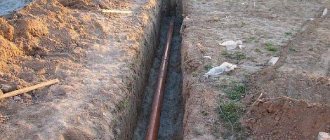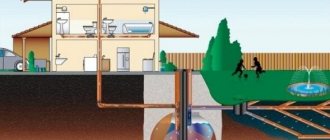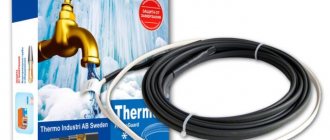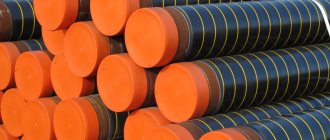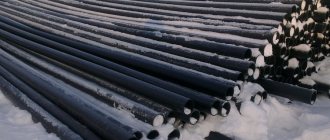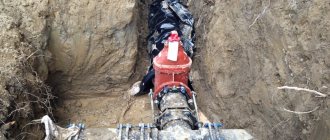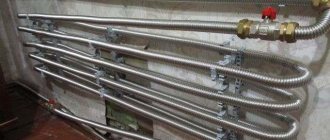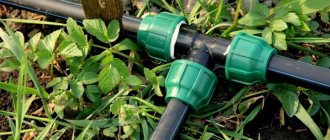People are accustomed to laying any communications underground. The explanation for this is very simple. The fact is that soil is a safer environment than air. Which pipe should I use for underground water supply? Builders often ask this question. The use of underground water pipes depends on many different factors.
The entire volume of passing groundwater is much less than the volume of precipitation, the impact of different temperatures is much weaker, and another plus is that underground pipes are much more difficult to damage than those laid on the surface.
Advantages and disadvantages
Advantages:
- Resistant to long-term gas exposure.
- The service life is about 100 years, if the pipeline is not overloaded.
- High level of flexibility. Thanks to this, it is possible to manufacture highways of complex configurations.
- Low weight of individual elements.
- No sediment accumulates on the smooth walls of the product.
- The material is not susceptible to rust.
Flaws:
- Not resistant to high temperatures.
- Plastic pipelines cannot be installed outdoors, as the material loses its technical characteristics in the cold.
- When heated strongly, the material expands. Because of this, to increase the strength of connections, individual sections of the pipeline need to install compensators.
- Low resistance to ultraviolet rays.
If you do not overload the pipeline, it will not break down and will withstand decades of active use.
Regulatory documents conditions and requirements for pipeline construction
The standards determine the laying of any pipeline, regardless of what material it is made of. Many technical issues are regulated in the so-called SNiPs.
Watch the video
They ensure safety and allow any work to be carried out efficiently. Here are a number of requirements that must be met for installation in the ground.
- Accounting is required for the point at which the soil freezes. Its level is often 1.4 meters. In winter, the water inside the water supply will simply freeze if it is located lower. The operation of the water supply will become impossible.
- The laying and its method may vary depending on what structures and structures are already present on the territory. And from the presence of highways, communication networks, highways. It is better to contact specialized companies if you are not completely sure about where to carry out the installation.
- The characteristics of the soil and topography are important for those who lay underground water pipes.
Why is thermal insulation needed?
Insulation of pipes is a necessary condition for their proper operation. If for some reason you were unable to install the pipeline at a depth of 1.4-1.6 meters, then thermal insulation will protect the fittings from low-temperature damage.
Important! Even if your region has warm, mild winters, you should not neglect thermal insulation. It is impossible to predict weather anomalies, and a sudden frost can cause a serious accident on the pipeline.
Mineral wool in rolls is used as thermal insulation for pipes, as well as special covers made of foamed polystyrene, polystyrene foam and rubber, which are placed over the pipes before welding. Insulating materials can also be supplied in the form of so-called. a shell consisting of two halves of a circle. When installing such insulation, it is fixed with special tape.
Rules for laying in the ground with your own hands
GOST says that for laying in the ground, pipes must have a diameter of at least 32 millimeters. For convenient and quick installation, a set of fittings is purchased.
Watch the video
- First, a trench is dug in the ground. Standards indicate that the depth of the trenches must exceed the freezing level of the soil. It is better to use special tables to determine the freezing level specifically for your region. 0.5 meters is the optimal width for the seam.
- We compact the trench - the bottom and also the walls.
- They create a cushion that provides shock absorption. For it, it is enough to pour a layer of, for example, sand gravel or sand of approximately 10 - 15 cm.
- It is mandatory to wrap the water supply pipe with a heat-insulating layer. Then the products are laid in a ditch and connected using fittings.
- We fill the pipeline with sand. The main thing is that the highest point is 5 centimeters higher than the pipeline itself.
- We cover the place where the water supply is located with tiles. In this case, broken bricks and tiles will become indispensable assistants.
- We fill the trench with earth. It is easy to understand that installing polypropylene pipes in the ground is not such a complicated process.
We dismantle the old water supply system
The first step in any installation of a plumbing system is to dismantle sections of the old pipeline. Steel products most often require complete replacement.
Installation using a grinder is the most convenient and simplest solution. After this, we begin laying polypropylene pipes for the new water supply system.
We suggest you read the article on how to independently lay a drainage pipeline at the entrance to a site
Advantages of using polypropylene pipes
Polypropylene pipes are optimal for laying sewer systems for summer cottages, supplying water for domestic needs, watering gardens, and greenhouses.
The use of polypropylene pipes today is justified in many areas, from water supply to sewerage. Among the advantages of using such pipes are:
- resistance to corrosion and various mechanical influences;
- ease of installation (trench method), which does not take much time;
- the possibility of using polypropylene pipes for supplying drinking water;
- reliability and strength.
Such pipes are optimal for laying sewer systems for summer cottages, supplying water for domestic needs, watering gardens, and greenhouses. In this case, all work is completed quickly, and the pipes themselves do not require complex and expensive maintenance.
Characteristics
The technical characteristics of the material determine the scope of its application. When making a gas pipeline, you can use different types of plastic pipes. Each of them has its own technical characteristics.
Metal-plastic parameters:
- High chemical resistance.
- The material is not subject to oxidation.
- The maximum coolant temperature is up to 95 degrees.
- The maximum permissible pressure is up to 25 bar. If the temperature is high, the permissible pressure is reduced to 10 bar.
- The thickness of the metal layer between the plastic is up to 0.3 mm.
Characteristics of polyethylene:
- outer diameter of tubes - 10–110 mm;
- maximum coolant temperature - up to 95 degrees;
- at high temperatures the maximum pressure is up to 10 bar.
Polypropylene parameters:
- maximum coolant temperature - 90 degrees;
- permissible pressure at maximum temperature - up to 10 bar.
Polypropylene pipes can withstand short-term overheating up to 110 degrees.
Diameter of plastic pipes
Independent search for underground pipes
The material from which the required elements are made is of great importance. This determines not only how to find water pipes in the ground, but also what to look for and what to do.
Technologies vary, and a modern method of independently searching for underground utilities can be aimed at determining the location of:
- Metal water pipes for hot and cold water.
- Steel heating “T” in collectors.
- Power cables and wires of communication systems.
- Cast iron sewer lines.
- Plastic, polyethylene, polypropylene pipelines;
- Metal-plastic and ceramic technical means of supply and drainage.
To fully probe an unfamiliar area for the presence of underground routes, all methods are used. In this case, the choice of technique depends on the installation depth and the actual operating pressure of the liquid inside the pipeline.
Application of a metal detector
If the pipe was laid at a depth of up to one and a half meters, it can be detected using metal detectors (professional, semi-professional or amateur). At the same time, the presence of insulation and waterproofing on the “T” does not interfere with the procedure.
The price of equipment can reach up to 130 thousand rubles. This means that for one-time use, its purchase is impractical. Cheap models cost up to 6 thousand, but they are less effective.
Suitable materials
The above requirements are better met by polymer pipes:
- polyethylene;
- metal-plastic;
- polypropylene.
Their service life exceeds 50 years. Polyvinyl chloride (PVC) products are usually used for sewage systems.
Polyethylene
Water pipes for laying in the ground, made of polyethylene, are used most often. They are not only able to withstand external soil pressure, but also shock loads. This allows them to be buried to a depth of up to 15 m.
Polyethylene pipes tolerate frost up to 60 °C, but at 10 °C they begin to lose their elasticity. They do not burst when water freezes in them, they just swell.
Polyethylene is resistant to aggressive environments, but is afraid of ultraviolet rays.
Thanks to the ability to bend pipes, the main can be laid without intermediate joints. But they are required at the exit from the source and at the entrance to the house.
For such connections, HDPE fittings are used, which have proven themselves well in summer cottages. But for home plumbing it is better to use more durable structures.
HDPE welding is used only for diameters from 160 mm.
Metal-plastic
Metal-plastic pipes are designed to bend both 90 and 180 degrees with a small radius. A small force is applied to change the configuration. After this, the form is saved.
Is it possible to use polypropylene pipes for gas?
In Western countries, metal pipes are used only for the assembly of industrial pipelines. In the manufacture of water and gas supply systems, plastic elements are used. This is due to the performance characteristics of the material. Gas flows through a plastic pipe without any difficulty. Before putting the gas pipeline into operation, it is necessary to check the tightness of the connections of individual elements in order to prevent violation of the integrity of the system.
You can figure out which is better – a pipeline made of metal or plastic – by comparing these two materials. Differences:
- Weight - plastic pipes weigh less than metal parts. Thanks to this, they are easier to install; they do not require additional fastenings on vertical surfaces.
- Versatility - There are more factors to consider when choosing metal pipes than when using plastic parts.
- Price - tubes made from polymers are cheaper than metal ones.
Metal tubes are superior to plastic ones in terms of strength, durability, and resistance to mechanical stress.
Trenchless installation methods
One of the promising methods for laying polypropylene pipes is trenchless installation, which has the following advantages:
- reduction of time and financial costs;
- minimizing harm to the environment;
- When laying, there is no need to dig trenches, destroy green spaces, or destroy asphalt pavement.
Today the following methods are used:
Renovation is a technology in which the old pipe is destroyed simultaneously with the laying of a new one. Only used when there is no longer enough bandwidth.
- Sanitation, that is, replacing old pipes with new ones. There are two ways to do the work:
- relining, which involves pulling a new polypropylene pipe into the old ones, but this will require a preliminary inspection of the condition of the existing pipe. It is necessary to make sure that there are no foreign objects or debris in it; the diameter of the old pipeline must be sufficient for laying a new one;
- renovation is a technology in which the old pipe is destroyed simultaneously with the laying of a new one. Only used when there is no longer enough bandwidth.
- Piercing is used when laying polypropylene pipes with a diameter of up to 150 mm. This work is carried out in several stages:
- first, two pits are dug along both parts of the route;
- then a hydraulic jack is placed in one of them, pushing a small steel pipe with a steel tip;
- when pushing, the pipe is expanded, a polypropylene pipe is inserted into its cavity;
- After the puncture, the pipeline is connected to the necessary systems.
Using this method, you can lay polypropylene pipes only in small sections; the method works great when it is necessary to lay them under a house, highway, garden, etc.
Polypropylene pipes for pipeline installation are used in many areas, from simple communications for country houses to sewer or water supply networks. Today, two methods of laying pipelines are used, but the most optimal is considered to be underground, which allows you not to touch above-ground structures and not spoil the landscape.
Laying in the ground has many advantages, despite the need to dig a pit. This allows you to keep them intact, out of reach of ultraviolet rays, and mechanical damage is also minimized.
Because You are not logged in. To come in.
Because The topic is archived.
What to do with insulation
For this, for example, special cases are used. The existing water supply is laid inside another pipe with a small diameter. This contributes to the formation of an air cushion between the walls of different products. Thanks to this, the heat of the water is retained.
Or the pipeline is simply poured using polystyrene concrete or foam concrete. This is a monolithic layer, with a base in the form of concrete with low weight and a porous structure.
The water supply is sometimes wrapped with insulation. Or a heating cable. The latter is laid both inside and outside the structure. It is recommended to carry out the gasket in two available ways:
- Two lines parallel to each other.
- In a spiral shape, around the water pipe.
Not every system is designed so that pressure increases without problems. But this method of protection can boast of effectiveness.
When high pressure remains inside, the liquid does not freeze. Even if there is no physical thermal insulation.
When installing external non-pressure types of sewerage, the so-called socket connection is used. The main thing is that there is no contamination on the plastic, then the connections will become highly sealed. Silicone or liquid soap is used to lubricate the parts that require connection.
Treatment with a sealant will provide additional protection during work such as laying water pipes from polypropylene pipes in the ground.
Only compliance with all requirements and technologies will allow you to obtain a water supply system that will function for a long time. And it will help reduce operating costs.
We are installing filters
If there is no scale or sand in the water, then elements such as fittings on toilet tanks, automatic washing machines, and ceramic faucets will last much longer.
It is enough to install the simplest filters, with rough cleaning. Without water purification filters, it is not advisable to lay polypropylene pipes yourself.
You should not give preference to filters that are disassembled manually. Inside such structures there are rubber seals, whose durability leaves much to be desired.
The preparation process depends on what type of pipes you have chosen. If it is galvanized, then we use a grinder to cut blanks of the sizes we need with our own hands. This can also be done using a hacksaw.
It is more convenient to cut metal-plastic or polypropylene products right on the spot. Even small errors in size will not be terrible.
When connecting, preference is given to two methods. For example, through a collector, which plays the role of wiring for individual devices, when each of them has its own fittings. Or through a simple tee.
We work with steel products
If you have the appropriate tools at hand, for example, such as welding, it is used to connect a metal structure.
It is easy to use to weld threads. Or bends that were bent on a special machine, the so-called pipe bender.
You can use dies or holders and do the work manually. Threaded connections are made in the same way as in the case of valves.
About metal-plastic pipes
In this case, the connection is made using fittings, which are equipped with union nuts. After cutting off the pipe section, proceed to chamfering from the inside using a knife. The union nut is put on the pipe along with a split ring.
Watch the video
We place the fitting from the fitting inside the pipe
The main thing is to act carefully, otherwise the rings with sealing characteristics will move. The nut is tightened just as carefully, without sudden movements.
Products with a polypropylene base
To get the job done, it will be enough to purchase an inexpensive soldering iron. We apply heat to the inner fitting surface by selecting the desired nozzle.
We do the same with the end where the polypropylene pipe is located. We insert one part into another, wait until everything cools down.
Installation rules
Before starting work, you need to draw up a diagram, mark on it all the necessary fittings and elements of the system (meters, filters, taps, etc.), mark the dimensions of the pipe sections between them. Using this scheme, we then calculate what and how much is needed.
When purchasing pipes, take with some reserve (a meter or two), fittings can be taken exactly according to the list. It wouldn't hurt to agree on the possibility of a return or exchange. This may be necessary, since often during the process, installation of a water supply system from polypropylene pipes throws up some surprises. They are mainly due to a lack of experience, and not to the material itself, and happen quite often even to masters.
Plastic clips take the same color
In addition to pipes and fittings, you will also need clips that secure everything to the walls. They are installed on the pipeline every 50 cm, as well as near the end of each branch. These clips are plastic, there are metal ones - staples and clamps with a rubber gasket.
For open laying of pipelines in technical rooms, it is more convenient to use staples; for better aesthetics - for open laying of pipes in the bathroom or kitchen - use plastic clips of the same color as the pipes themselves.
Metal clamps are good in technical rooms
Now a little about the assembly rules. The system itself can be assembled immediately by cutting pipe sections of the required length, constantly checking the diagram. It's easier to solder this way. But, with a lack of experience, this is fraught with mistakes - you must measure accurately and do not forget to add 15-18 millimeters (depending on the diameter of the pipes) that go into the fitting.
Therefore, it is more rational to draw the system on the wall, designate all the fittings and elements. You can even attach them and trace the outlines. This will make it easier to evaluate the system itself and identify shortcomings and errors, if any. This approach is more correct, as it gives greater accuracy.
Next, the pipes are cut as needed, and fragments of several elements are connected on the floor or work table. Then the finished fragment is installed in place. This sequence of actions is the most rational.
And about how to quickly and correctly cut sections of pipe of the required length and not make mistakes.
Anatoly Rytsev / Master - all-rounder, website author
The master is a generalist. Engaged in interior and facade finishing work of all types: painting, plastering, wallpapering, all types of tiling work, as well as the construction of country houses and plant growing.
Conditions of conduct according to regulatory documents
The laying of any pipeline, be it polypropylene or steel, is determined by standards. It is SNiP that regulates many technical issues that allow all work to be completed efficiently, ensuring safety. To lay polypropylene pipes, the following requirements must be met:
Diagram of the advantages of polypropylene pipes over other materials
- It is imperative to take into account the freezing point of the soil. Usually it is at a level of 1.4 meters, so if the pipeline is at a lower level, then in winter the water in it will simply freeze and it will be impossible to use the pipe. Therefore, during installation it is necessary to accurately calculate such moments; in the future this will only be beneficial.
- The laying of pipes largely depends on what buildings are located on the site, whether there are nearby roads and highways, communication and other utility networks. If you are not sure where exactly the pipeline can be laid, it is better to contact specialized construction companies.
- When laying underground, we also take into account the characteristics of the relief and soil; in some cases it is necessary to protect the pipe with the help of special casings.
The polypropylene pipeline is laid subject to the following steps:
- First you will have to prepare a trench for laying, which should be larger than the diameter of the pipe. So, for 110 mm pipes you will need a trench with a width of 600 mm. The minimum distance between the pipe wall and the trench should be 20 cm. The burial depth should be 50 cm greater.
- The bottom is sprinkled with sand with a cushion thickness of approximately 50-100 mm, after which the sand is compacted.
- The laying starts from the building; when installing sewer pipes, the socket should face the end of the pipe going outside;
- A special lubricant is used to connect individual elements.
- When laying sewerage, you must remember that a slope of 2 cm must be maintained for every meter of the route.
- After installation, the pipeline is covered with sand and compacted only from the sides. If necessary, before this the pipe is wrapped with a heat-insulating layer;
- At the very end, polypropylene pipes are connected to a common highway, treatment plant, etc. This must be done using polypropylene solder.
What problems may arise during installation?
When laying polypropylene pipes underground, some problems may arise:
- the structure of the soil does not allow digging to the required depth;
- in winter, the soil freezes strongly, which can cause damage to pipes;
- There is a building on the site that is not possible to get around.
In this case, there are several ways to solve these problems:
- If the soil is too loose or hard, it is recommended to make a puncture, in which a steel pipe is first laid, and a polypropylene pipeline is inserted into its cavity.
- When the ground freezes, it is recommended to lay a heating cable along the entire route. This requires significant costs, and expenses in winter may exceed those planned, but in any case, this option is cheaper than constantly repairing burst pipes.
- If there is any structure or object along the route that cannot be damaged, it is recommended to use trenchless construction methods, that is, puncture. In this case, you can not only lay the pipeline, but also protect it with a steel casing. When laying such networks, it is necessary to carefully look at the layout of communications on the site so as not to damage existing ones.
Possible problems
Sometimes it happens that the structure of the soil does not allow digging to the required depth. Or ground freezing of the ground occurs with such force that the water supply is damaged.
But a way out can always be found. For example, make a puncture if the ground is too loose. First, a steel pipe is laid in the hole, and a polypropylene pipeline is installed inside it.
Additional protection against freezing - heating cables located along the entire length. But such work is associated with additional costs.
Trenchless installation methods are finally a great solution for those who are faced with an obstacle that cannot be bypassed.
